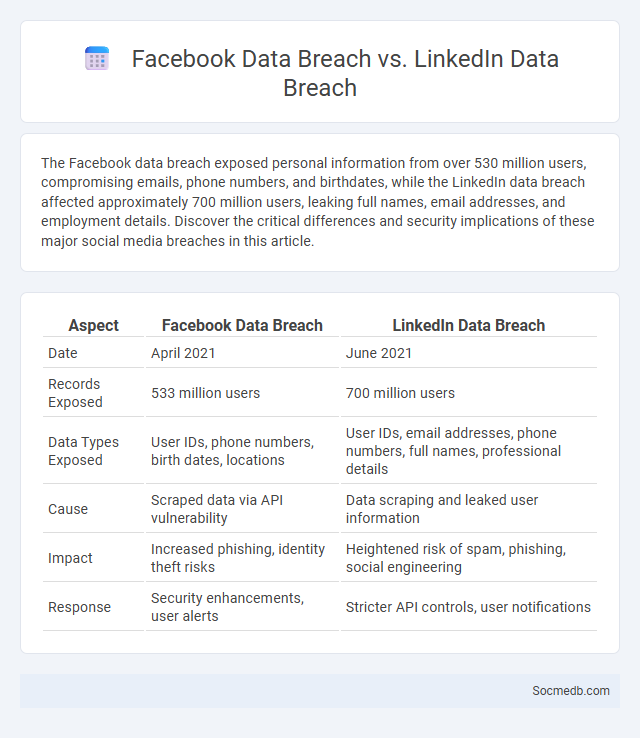
Photo illustration: Facebook Data Breach vs LinkedIn Data Breach
The Facebook data breach exposed personal information from over 530 million users, compromising emails, phone numbers, and birthdates, while the LinkedIn data breach affected approximately 700 million users, leaking full names, email addresses, and employment details. Discover the critical differences and security implications of these major social media breaches in this article.
Table of Comparison
| Aspect | Facebook Data Breach | LinkedIn Data Breach |
|---|---|---|
| Date | April 2021 | June 2021 |
| Records Exposed | 533 million users | 700 million users |
| Data Types Exposed | User IDs, phone numbers, birth dates, locations | User IDs, email addresses, phone numbers, full names, professional details |
| Cause | Scraped data via API vulnerability | Data scraping and leaked user information |
| Impact | Increased phishing, identity theft risks | Heightened risk of spam, phishing, social engineering |
| Response | Security enhancements, user alerts | Stricter API controls, user notifications |
Overview of Major Social Media Data Breaches
Major social media data breaches have exposed billions of user records, compromising personal information such as email addresses, phone numbers, and passwords. High-profile incidents involving platforms like Facebook, Twitter, and LinkedIn highlight vulnerabilities in data storage and security protocols that hackers exploit. Protecting Your digital footprint requires vigilance in monitoring account activity and updating privacy settings to mitigate risks associated with these widespread breaches.
What is a Data Breach?
A data breach occurs when unauthorized individuals gain access to sensitive, protected, or confidential information stored on social media platforms, compromising users' personal data such as login credentials, private messages, and financial details. This security incident can result from hacking, phishing attacks, or vulnerabilities within the platform's system, leading to exposure or theft of user information. Protecting against data breaches requires robust encryption, regular security audits, and user awareness to mitigate risks and safeguard digital privacy.
Facebook Data Breach: Key Facts and Timeline
The Facebook Data Breach exposed personal information of over 500 million users, including phone numbers, full names, and locations, raising significant privacy concerns worldwide. This massive leak, first discovered in 2021, originated from a vulnerability in Facebook's contact importer tool that was patched in 2019 but exploited afterward. You should regularly check your account privacy settings and use tools like Facebook's Security Checkup to minimize risks related to your data security.
LinkedIn Data Breach: Key Facts and Timeline
The LinkedIn data breach exposed over 700 million user records, including email addresses, phone numbers, and professional details, making it one of the largest social media leaks. The breach, first identified in June 2021, involved hackers exploiting a vulnerability to scrape and aggregate data from public LinkedIn profiles. This incident underscores the critical need for enhanced cybersecurity measures and user vigilance on professional networking platforms.
Causes Behind Facebook and LinkedIn Data Breaches
Facebook and LinkedIn data breaches often result from weak password management and inadequate access controls, exposing vast amounts of user information. Cybercriminals exploit vulnerabilities in outdated software and phishing attacks targeting employee credentials to gain unauthorized access. Insufficient encryption protocols and third-party application integrations further increase the risk of sensitive data being compromised.
Comparing Scale and Impact: Facebook vs LinkedIn
Facebook boasts over 2.9 billion monthly active users, creating a vast social network primarily focused on personal connections and entertainment, while LinkedIn, with more than 900 million professionals, is tailored for career development and business networking. Your choice between the two depends on your goals: Facebook excels in broad audience engagement and brand awareness, whereas LinkedIn drives targeted professional interactions and B2B lead generation. The impact of Facebook is measured by its extensive reach and user engagement, whereas LinkedIn's strength lies in fostering meaningful professional relationships and industry influence.
User Data Exposed: What Information Was Compromised?
User data exposed in social media breaches often includes personal information such as names, email addresses, phone numbers, and birthdates, which cybercriminals can exploit for identity theft or phishing attacks. In some cases, more sensitive data like private messages, login credentials, and location history are compromised, increasing the risk to your digital security. Understanding the specific types of data exposed helps you take targeted steps to safeguard your personal information and privacy on social platforms.
Consequences for Users and Companies
Social media significantly impacts users by influencing their mental health, privacy, and behavior patterns, often leading to increased anxiety, addiction, and exposure to misinformation. Companies leveraging social media face both opportunities and risks, including enhanced brand visibility, targeted advertising capabilities, and potential reputational damage from public backlash or data breaches. Effective social media strategies thus require balancing engagement with ethical considerations and robust cybersecurity measures to mitigate negative outcomes.
Prevention Strategies: Lessons from Facebook and LinkedIn
Facebook and LinkedIn implement robust content moderation algorithms and user reporting mechanisms to prevent misinformation and harmful behavior. Both platforms invest in AI-driven detection systems and employ dedicated safety teams to monitor and mitigate online threats. Their combined strategies emphasize user education, transparent policies, and proactive intervention to enhance digital trust and security.
The Future of Data Security in Social Media
The future of data security in social media demands advanced encryption technologies and rigorous privacy protocols to protect user information from increasing cyber threats. Artificial intelligence and machine learning will play crucial roles in detecting and preventing data breaches in real time. Your online presence requires continuous vigilance and adoption of cutting-edge security measures to ensure personal data remains secure in evolving digital landscapes.
 socmedb.com
socmedb.com